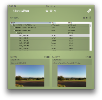


When two files have a filename collision, where are the two files and how was it handled?įor more information, take a look at using the home screen, using the history screen, and viewing sift history.Why was a specific file deemed a duplicate? Where is the duplicate?.Once sifting is complete, you can see a detailed log of what Silent Sifter did with your files during the sifting process, and why. A five-second audible alarm sounds at completion. Mechanical hammer assembly then taps against each sieve to aid the passage of particles through the sieve cloth. Two rubber-covered stainless-steel drive rollers continuously rotate the test sieve stack. By default, the original files remain intact in the input folders (unless you have explicitly told Silent Sifter to take action on the inputs).įor more information, learn more about Using the Home Screen. The silent sifter is great for enhanced worker protection and reductive of noise levels. Files will be pulled from the input locations, processed, deduplicated, filtered, renamed, and copied into the output locations you specified.Heavy-duty, over-center lever latches pull doors tightly against case gaskets, ensuring a tight, dust-proof seal that enhances noise control. The next step is to tell Silent Sifter to process all of the inputs and organized them into your outputs. This Sifter uses advanced soundproofing materials and techniques for models 16 - 18dB quieter than standard rotary sifters and 8-10dB quieter than the Original Silent Sifter. Learn more about Customizing Input/Output behavior. If you want to customize, there are a plethora of possibilities.

SILENT SIFTER HOW TO
In both of these ways, you can ensure that Silent Sifter organizes all of the files you want, the way you want them.This section is a quick jumpstart on how to get things working. You can even create your own Types of your choosing, for example ‘Documents’ for DOC files. It does this using OSX’s marker for each file, as well as Silent’s Sifter’s own extensive mapping list.īy including a file extension override, you are forcing Silent Sifter to mark a set of files with the type that you choose, whether that be marking an MPG file as a ‘Photo’, or marking a JPG file as a ‘Video’.

Silent Sifter categorizes every file as either ‘Photo’, ‘Video’, or ‘Other’. The second step is indexing metadata about the file. By including a file extension override, you will ensure that Silent Sifter locates all files of that type within your input folders, and includes it in your sift. Also, you may want a file to be sifted as if it was a media file, even though it is not. Even so, there are lots of media file types that neither Silent Sifter nor OSX is aware of. This list is extensive, including everything that OSX thinks is a media file, as well as a long list of files that Silent Sifter knows are media files, but OSX does not. When Silent Sifter searches your inputs for files to sift, it is looking for files that it believes are media files. The first step is locating files to sift. These new options override Silent Sifter’s default behavior in two of the steps that occur during a sift.


 0 kommentar(er)
0 kommentar(er)
